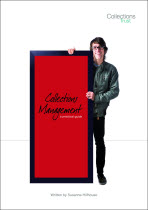
PAS 197 has recently been published as a new standard, sponsored by the Collections Trust and developed by the BSI. At this week’s meeting of the Archives and Records Association’ Data Standards Group we heard more about the involvement of archivists in the development of the standard. This came about originally following a talk at the DSG by Nick Poole of the Collections Trust; there was a feeling that it was important to ensure the standard met the requirements of archives as well as museums and libraries. Susan Snell (Archivist at the Library of Freemasonry) and Teresa Doherty (Collections Manager at The Women’s Library) put themselves forward to work on a standard for collections management that would be truly cross-domain, and look to fulfill the MLA ideal of one standard for all three sectors.
Essentially, what we needed was a standard that said what we do with materials in our care. The Collections Trust approached the British Standards Institute (BSI) to develop a publicly available specification (PAS) that would provide a broad overview of how heritage collections should be managed. Susan and Teresa only became involved after a number of meetings, but from the presentation that they gave, we were in no doubt that they made their voices heard very successfully. Dr Norman James ( TNA) and Christopher Marsend (V&A) was also there representing our profession.
PAS 197 sets out clearly how you manage an archive and how and why archives are different from other collections. It gives a broad overview of how the collections should be managed and lists the key standards. Susan and Teresa explained to us the way that the different contexts within which we work can create barriers. For example, the museum fraternity talk about ‘objects’, which is not appropriate for archives (‘item’ was used instead in PAS 197, as the best compromise). There was a danger that the standard would not lead to cross-sectoral compatibility if these issues were not addressed, but it needed to be a consensus document.
Teresa emphasised that PAS 197 is not aimed at the average archivist or curator or librarian; it is aimed at senior managers, or at helping us to deal more effectively with senior managers, funders and other similar stakeholders. It codifies our best practice for our boards and financial advisers. It sets out what needs to be resourced.
Teresa pointed out a diagram within the standard that summarises the four main areas of work:
i) Developing collections – acquisitions and disposals
ii) Information procedures – catalogues, indeces, survey lists, accessions registers, etc.
iii) Access
iv) Care and conservation
This may seem straightforward to us, but it needs to be spelt out. We should have policies, procedures and documentation for these areas, and resources directed to each area. Teresa and Susan pointed out that the scale should be suitable for the repository. A very small repository may just need one document with four paragraphs addressing each area of collections management. Also, it is a generic model, so it can apply to cross-domain collections. The four areas map to what is required for accredication for musuems and TNA self-assessment. The area that is not addressed in PAS is governance, which is also part of accreditation. This is addressed by other BSI standards.
Susan took us through a diagram that sets out processing collections and clarifies terminology – pre-accession, accession, appraisal, cataloguing, deaccessioning/disposal. So, for example, accession in archives is the same as acquisition in the museum and library world, and appraisal only happens in the archival world.
Susan and Teresa felt that working with the BSI was very productive. They were very professional and gave a neutral perspective, looking to ensure a balanced approach so that all voices were heard. They also told us that we should be pleased with ourselves as a profession, as we lead the way in terms of the development of useful standards to help us do our work more effectively – see the appendix of the standard for proof of this!
We were informed that there is a move for archives to get accreditaion by 2012, to take over the TNA self-assessment scheme. There may be issues around scalability here, but hopefully, if the accredication procedure is guided by PAS 197, it will be achievable for very small collections. Cross-domain accreditation may encourage institutions that are primarily museums or libraries to ensure that their archives are well cared for, catalogued to the appropriate standards and accessible for use.
The Collections Trust have now produced Collections Management: a practical guide (by Susanna Hillhouse, priced at £29.99).
If you are interested in getting a copy of PAS 197, being a BSI standard, it is a little expensive, at about £56. But, it sounds like it may be well worth having. Thumbs up to Susan and Teresa for helping to ensure that this key standard is relevant for archives as well as museums and libraries.

